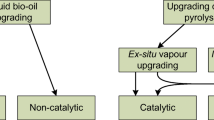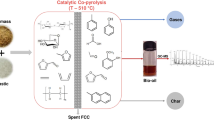Abstract
Studies on the co-pyrolysis of plastic waste and biomass to obtain sustainable liquid fuel, while reducing the amount of unwanted plastics and agricultural solid residues, have gained global attention recently. The purpose of this work was to investigate the thermal, kinetics, and thermodynamic events that occurred during the pyrolysis of binary polyolefin (PO) mixture, oil palm fibre (OPF), and their blends (ternary mixtures) at 5, 10, 15, and 20 °C/min using a thermogravimetric analyser (TGA). The pyrolysis and co-pyrolysis reactions at different heating rates were categorised into different reaction zones. The single reaction zone for the PO mixture started from 221 to 510 °C, while the first, second, and third reaction zones for OPF started from 30 to 132 °C, 223–315 °C, and 299–557 °C, respectively. The first, second, and third reaction zones for the co-pyrolysis of PO mixture with OPF started from 210 to 319 °C, 298–382 °C, and 375–525 °C, respectively. The enthalpy changes were in the range of 355–146 kJ/mol, 149–164 kJ/mol, and 164–261 kJ/mol for PO mixtures, OPF, and their blend, respectively, under a heating rate that ranged between 5 and 20 °C/min. The thermal analysis of these materials indicated that the activation energies needed to achieve the thermal degradation of PO mixture were higher than for the thermal degradation of the OPF. The heating rate of 10 °C/min was found to be suitable for the co-pyrolysis of the samples based on the low activation energy. The results further showed that the co-pyrolysis of polyolefin mixtures with biomass could significantly reduce the energy inputs of the process by drastically reducing the activation energy of the reaction.







Similar content being viewed by others
Data availability
All data generated or analysed during this study are included in this published article.
References
Bogdanov D, Gulagi A, Fasihi M, Breyer C (2021) Full energy sector transition towards 100% renewable energy supply: integrating power, heat, transport and industry sectors including desalination. Appl Energy 283:116273. https://doi.org/10.1016/j.apenergy.2020.116273
Zhang Y, Yu Z, Zhang X, Ma X (2021) Comparative study on the synergistic co-pyrolysis of Thlaspi arvense L. seed with different plastics: thermal behaviors, product distributions, and kinetics analysis. Biomass Convers Biorefinery. https://doi.org/10.1007/s13399-021-01712-6
Jubinville D, Esmizadeh E, Saikrishnan S et al (2020) A comprehensive review of global production and recycling methods of polyolefin (PO) based products and their post-recycling applications. Sustain Mater Technol 25:e00188. https://doi.org/10.1016/j.susmat.2020.e00188
Pinto da Costa J (2021) The 2019 Global pandemic and plastic pollution prevention measures: playing catch-up. Sci Total Environ 774:145806. https://doi.org/10.1016/j.scitotenv.2021.145806
Chew KW, Chia SR, Chia WY et al (2021) Abatement of hazardous materials and biomass waste via pyrolysis and co-pyrolysis for environmental sustainability and circular economy. Environ Pollut 278:116836. https://doi.org/10.1016/j.envpol.2021.116836
Gin AW, Hassan H, Ahmad MA et al (2021) Recent progress on catalytic co-pyrolysis of plastic waste and lignocellulosic biomass to liquid fuel: the influence of technical and reaction kinetic parameters. Arab J Chem 14:103035. https://doi.org/10.1016/j.arabjc.2021.103035
Parthasarathy P, Alherbawi M, Pradhan S (2022) Pyrolysis characteristics, kinetic, and thermodynamic analysis of camel dung, date stone, and their blend using thermogravimetric analysis. Biomass Convers Biorefinery. https://doi.org/10.1007/s13399
Patnaik AS, Goldfarb JL (2016) Continuous activation energy representation of the Arrhenius equation for the pyrolysis of cellulosic materials: feed corn stover and cocoa shell biomass. Cellul Chem Technol 50:311–320
Van Nguyen Q, Choi YS, Choi SK et al (2021) Co-pyrolysis of coffee-grounds and waste polystyrene foam: synergistic effect and product characteristics analysis. Fuel 292:120375. https://doi.org/10.1016/j.fuel.2021.120375
Özsin G, Pütün AE, Pütün E (2019) Investigating the interactions between lignocellulosic biomass and synthetic polymers during co-pyrolysis by simultaneous thermal and spectroscopic methods. Biomass Convers Biorefinery 9:593–608. https://doi.org/10.1007/s13399-019-00390-9
Çepelioǧullar Ö, Pütün AE (2013) Thermal and kinetic behaviors of biomass and plastic wastes in co-pyrolysis. Energy Convers Manag 75:263–270. https://doi.org/10.1016/j.enconman.2013.06.036
Karuppasamy Vikraman V, Praveen Kumar D, Boopathi G, Subramanian P (2021) Kinetic and thermodynamic study of finger millet straw pyrolysis through thermogravimetric analysis. Bioresour Technol 342:125992. https://doi.org/10.1016/j.biortech.2021.125992
Fan Y, Lu D, Wang J, Kawamoto H (2022) Thermochemical behaviors, kinetics and bio-oils investigation during co-pyrolysis of biomass components and polyethylene based on simplex-lattice mixture design. Energy 239:122234. https://doi.org/10.1016/j.energy.2021.122234
Fan Y, Lu D, Wang J, Kawamoto H (2021) Thermochemical behaviors, kinetics and bio-oils investigation during co-pyrolysis of biomass components and polyethylene based on simplex-lattice mixture design. Energy 239:122234. https://doi.org/10.1016/j.energy.2021.122234
Vanapalli KR, Bhattacharya J, Samal B et al (2021) Inhibitory and synergistic effects on thermal behaviour and char characteristics during the co-pyrolysis of biomass and single-use plastics. Energy 235:121369. https://doi.org/10.1016/j.energy.2021.121369
Saad JM, Williams PT, Zhang YS et al (2021) Comparison of waste plastics pyrolysis under nitrogen and carbon dioxide atmospheres: a thermogravimetric and kinetic study. J Anal Appl Pyrolysis 156:105135. https://doi.org/10.1016/j.jaap.2021.105135
Das P, Tiwari P (2017) Thermal degradation kinetics of plastics and model selection. Thermochim Acta 654:191–202. https://doi.org/10.1016/j.tca.2017.06.001
Palmay P, Puente C, Barzallo D, Bruno JC (2021) Determination of the thermodynamic parameters of the pyrolysis process of post-consumption thermoplastics by. Polymers (Basel) 13:
Ahmad MS, Liu CG, Nawaz M et al (2021) Elucidating the pyrolysis reaction mechanism of Calotropis procera and analysis of pyrolysis products to evaluate its potential for bioenergy and chemicals. Bioresour Technol 322:124545. https://doi.org/10.1016/j.biortech.2020.124545
Sahoo A, Gautam R, Kumar S, Mohanty K (2021) Energy optimization from a binary mixture of non-edible oilseeds pyrolysis: Kinetic triplets analysis using thermogravimetric analyser and prediction modeling by artificial neural network. J Environ Manage 297:113253. https://doi.org/10.1016/j.jenvman.2021.113253
Sharypov VI, Marin N, Beregovtsova NG et al (2002) Co-pyrolysis of wood biomass and synthetic polymer mixtures. Part I: influence of experimental conditions on the evolution of solids, liquids and gases. J Anal Appl Pyrolysis 64:15–28. https://doi.org/10.1016/S0165-2370(01)00167-X
Hu B, Serranti S, Fraunholcz N et al (2013) Recycling-oriented characterization of polyolefin packaging waste. Waste Manag 33:574–584. https://doi.org/10.1016/j.wasman.2012.11.018
Kumar Mishra R, Mohanty K (2020) Co-pyrolysis of waste biomass and waste plastics (polystyrene and waste nitrile gloves) into renewable fuel and value-added chemicals. Carbon Resour Convers 3:145–155. https://doi.org/10.1016/j.crcon.2020.11.001
Abnisa F, Arami-Niya A, Wan Daud WMA et al (2013) Utilization of oil palm tree residues to produce bio-oil and bio-char via pyrolysis. Energy Convers Manag 76:1073–1082. https://doi.org/10.1016/j.enconman.2013.08.038
Çit I, Sinaǧ A, Yumak T et al (2010) Comparative pyrolysis of polyolefins (PP and LDPE)and PET. Polym Bull 64:817–834. https://doi.org/10.1007/s00289-009-0225-x
Chen WH, Lin BJ (2016) Characteristics of products from the pyrolysis of oil palm fiber and its pellets in nitrogen and carbon dioxide atmospheres. Energy 94:569–578. https://doi.org/10.1016/j.energy.2015.11.027
Zakaria MR, Norrrahim MNF, Hirata S, Hassan MA (2015) Hydrothermal and wet disk milling pretreatment for high conversion of biosugars from oil palm mesocarp fiber. Bioresour Technol 181:263–269. https://doi.org/10.1016/j.biortech.2015.01.072
Miranda R, Pakdel H, Roy C, Vasile C (2001) Vacuum pyrolysis of commingled plastics containing PVC II Product analysis. Polym Degrad Stab 73:47–67. https://doi.org/10.1016/S0141-3910(01)00066-0
Florentino-Madiedo L, Vega MF, Díaz-Faes E, Barriocanal C (2021) Evaluation of synergy during co-pyrolysis of torrefied sawdust, coal and paraffin A kinetic and thermodynamic study. Fuel 292:120305. https://doi.org/10.1016/j.fuel.2021.120305
Haykiri-Acma H, Yaman S, Kucukbayrak S (2006) Effect of heating rate on the pyrolysis yields of rapeseed. Renew Energy 31:803–810. https://doi.org/10.1016/j.renene.2005.03.013
Chen X, Sun-Waterhouse D, Yao W et al (2021) Free radical-mediated degradation of polysaccharides: Mechanism of free radical formation and degradation, influence factors and product properties. Food Chem 365:130524. https://doi.org/10.1016/j.foodchem.2021.130524
Hussin MH, Pohan NA, Garba ZN et al (2016) Physicochemical of microcrystalline cellulose from oil palm fronds as potential methylene blue adsorbents. Int J Biol Macromol 92:11–19. https://doi.org/10.1016/j.ijbiomac.2016.06.094
Rathamat Z, Choorit W, Chisti Y, Prasertsan P (2021) Two-step isolation of hemicellulose from oil palm empty fruit bunch fibers and its use in production of xylooligosaccharide prebiotic. Ind Crops Prod 160:113124. https://doi.org/10.1016/j.indcrop.2020.113124
Miteva K, Slavcho A, Bogoeva-Gaceva G (2016) Kinetic analysis of pyrolysis of waste polyolefin mixture. Arab J Sci Eng 41:2601–2609. https://doi.org/10.1007/s13369-016-2092-8
Wu F, Ben H, Yang Y et al (2020) Effects of different conditions on co-pyrolysis behavior of corn stover and polypropylene. Polymers (Basel) 12. https://doi.org/10.3390/POLYM12040973
Mishra RK, Sahoo A, Mohanty K (2019) Pyrolysis kinetics and synergistic effect in co-pyrolysis of Samanea saman seeds and polyethylene terephthalate using thermogravimetric analyser. Bioresour Technol 289:121608. https://doi.org/10.1016/j.biortech.2019.121608
Sun C, Li W, Chen X et al (2021) Synergistic interactions for saving energy and promoting the co-pyrolysis of polylactic acid and wood flour. Renew Energy 171:254–265. https://doi.org/10.1016/j.renene.2021.02.099
Funding
The authors thankfully acknowledge the support shown by Lotte Chemical Titan (M) Sdn Bhd, Pasir Gudang, Johor, Malaysia, and Universiti Sains Malaysia (Grant Number: 304/PJKIMIA/6050422/L128) in the form of research grant and facilities.
Author information
Authors and Affiliations
Contributions
Investigation, writing—original draft: A. W. Gin. Writing—review and editing: H. Hassan. Funding, supervision, writing—review and editing: M. A. Ahmad. Supervision, writing—review and editing: B. H. Hameed. Supervision, writing—review and editing: A. T. Mohd Din.
Corresponding author
Ethics declarations
Ethical approval
Not applicable.
Consent to participate
Not applicable.
Consent to publish
Not applicable.
Competing interests
The authors declare no competing interests.
Additional information
Publisher's note
Springer Nature remains neutral with regard to jurisdictional claims in published maps and institutional affiliations.
Rights and permissions
About this article
Cite this article
Gin, A.W., Hassan, H., Ahmad, M.A. et al. Co-pyrolysis of polyolefin mixtures and oil palm fibre for the production of liquid fuel: kinetics and thermodynamic study. Biomass Conv. Bioref. 14, 6381–6395 (2024). https://doi.org/10.1007/s13399-022-02822-5
Received:
Revised:
Accepted:
Published:
Issue Date:
DOI: https://doi.org/10.1007/s13399-022-02822-5




